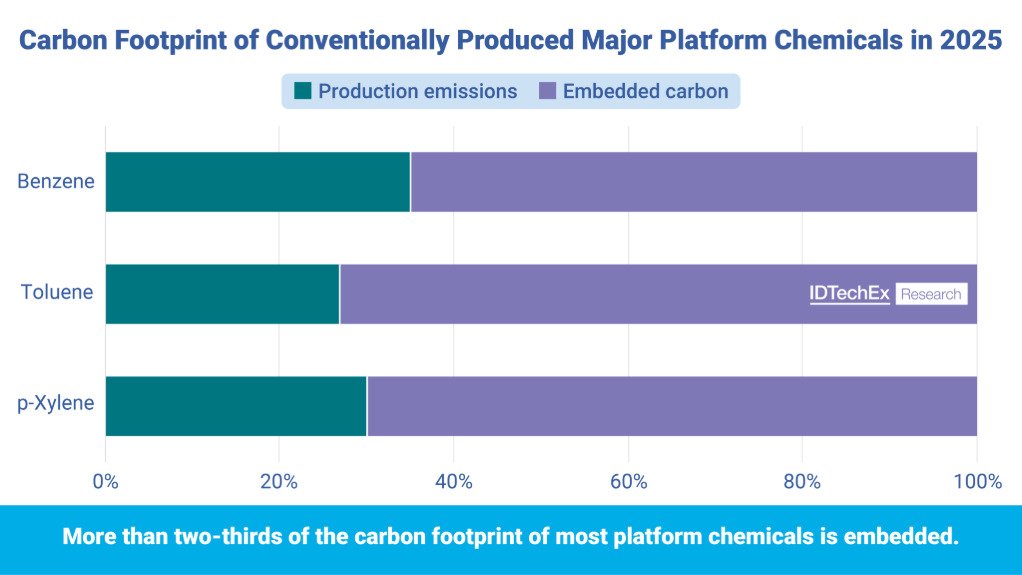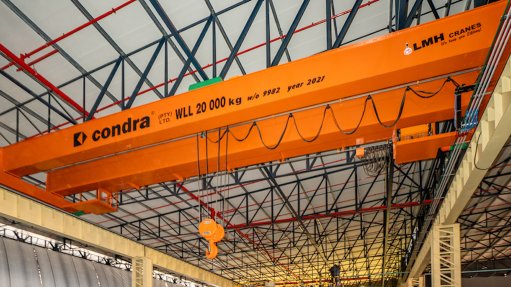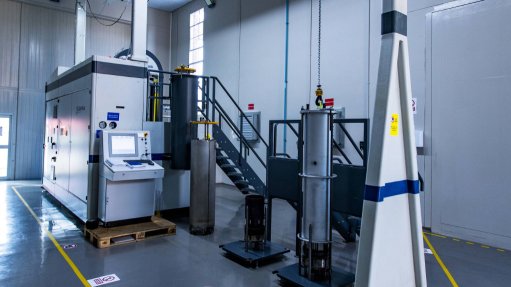Company highlights extraction technology for lignin applications


COMPELLING STUDY Research into lignin extraction technologies is crucial for enabling high-value applications of lignin, moving it beyond its traditional use as a fuel source
Photo by IDTechEX
In the drive to decarbonise chemical production, some of the most promising solutions come from unexpected places, says independent emerging technologies research company IDTechEx, adding that lignin, once largely burned for energy, is now being explored as a valuable input for a range of green applications.
As the industry looks beyond fossil fuels, lignin is gaining new relevance as a renewable chemical feedstock with “untapped potential”. Simultaneously, various emerging manufacturing technologies are “jostling for position in the race to define the future of sustainable chemical production”.
As the chemical industry continues its shift toward sustainability, attention is turning to next-generation feedstocks. These are derived from renewable and waste sources and serve to cut carbon emissions and reduce fossil dependency.
These chemical feedstocks are the focus of the IDTechEx report, ‘Next-Generation Feedstocks for Sustainable Chemicals 2025–2035: Markets, Players, Forecasts’. The report provides in-depth insight into key technologies, industry trends and commercial opportunities that will shape the future of green chemical production.
Currently, over two-thirds of emissions associated with chemical production are embedded emissions.
Among the most promising yet underused components of these next-generation renewable inputs is lignin, says IDTechEx. Lignin is an aromatic polymer found in lignocellulosic biomasses, such as wood and agricultural residues. Unlike other biopolymers, such as cellulose and hemicellulose, which are widely used to produce bio-based sugars and chemicals, lignin has long been relegated to low-value uses, chiefly incinerated to generate process heat. “In fact, around 95% of lignin produced globally is burned, with only a small fraction repurposed in applications such as animal feed.”
IDTechEx states that this underuse represents a “massive” opportunity.
“If lignin can be efficiently extracted in high-quality forms, it has the potential to replace petroleum-derived products in a wide range of applications.”
The range spans bitumen replacement for road surfacing to battery anodes and sustainable packaging. New extraction technologies are now unlocking this potential, transforming lignin from a waste by-product into a valuable resource.
IDTechEx explores three of the many innovative extraction technologies in its recent report, highlighting the pioneering work of Sonichem, Lixea and Anellotech.
Unlocking Odour-Free Lignin
The IDTechEx report states that UK-based Sonichem is pioneering a low-energy lignin extraction technology using ultrasonic cavitation. This process begins with sawdust, which is dissolved in water to form an aqueous mixture. “Ultrasonic waves then generate extremely localised high temperatures and pressures, breaking apart the complex bonds between lignin, cellulose and hemicellulose. A recyclable organic solvent assists in the separation and the method operates at relatively low temperatures, enhancing energy efficiency and process safety.”
IDTechEx points out that this results in a low molecular weight lignin (around 2 000 g/mol), which is odour-free and soluble in organic solvents. At pilot scale, Sonichem is already producing lignin valued at £2 500/t, more than four times the value of bio-based sugars. This positions lignin as a strong candidate for specialty applications such as adhesives, coatings and composites.
With a commercial plant planned in Scotland and first revenues expected by 2027, Sonichem is “poised to tap into a feedstock that is abundant, renewable and underexploited”.
Low-Energy Wood Fractionation
Sweden-based Lixea, meanwhile, has developed the Dendronic Process, which uses ionic liquids to fractionate lignocellulosic biomass into its three primary components: cellulose, hemicellulose and lignin.
This solvent-based extraction method is notable for its low-temperature and low-energy requirements, owing to the unique properties of ionic liquids. Unlike traditional processes that rely on volatile or toxic chemicals, the Dendronic Process ionic liquids are non-volatile, non-flammable and recyclable solvents, “offering a safer and more sustainable alternative for biomass processing,” the report states.
Lixea’s pilot plant in Sweden, commissioned in 2022, has demonstrated the scalability and performance of this technology. In 2025, the company was awarded €21.5-million in funding from the European Council Innovation Fund to further develop and commercialise the process with a “first-of-its-kind” pre-commercial demo plant.
The high-quality lignin extracted is being evaluated for use in applications such as thermoplastics, carbon fibres and construction materials – sectors that are actively seeking sustainable inputs with lower embodied carbon.
BTX from Biomass
In the US, Anellotech is advancing the production of bio-based benzene, toluene, xylene (BTX), key aromatic compounds used in everything from plastics to foams and textiles. Its proprietary Bio-TCAT process thermally converts non-food biomass such as pine wood into BTX in a single-step, energy-self-sufficient process.
IDTechEx notes that Anellotech uses a fluidised bed reactor to break down the biomass and catalytically reform it into aromatics. Unlike conventional methods that require hydrogen or multiple processing steps, Bio-TCAT generates its own energy from residual biomass, contributing to a significantly lower carbon footprint and more favourable economics.
“The ability to produce drop-in petrochemical replacements from renewable feedstocks positions Anellotech as a critical enabler of green aromatics, a cornerstone of future sustainable materials and fuels,” IDTechEx comments.
Toward a Sustainable Future
IDTechEx avers that these three companies are among many others that are spearheading the shift towards sustainable chemical production. “They are laying the groundwork for a future where a wide range of chemicals and materials can be produced from next-generation feedstocks.”
As detailed in IDTechEx’s report, the market for chemicals derived from next-generation feedstocks is expected to grow at a 16% compound annual growth rate between 2025 and 2035, with lignin playing a central role in replacing fossil-derived aromatics. The report analyses the technical, economic, and policy factors shaping this landscape.
Article Enquiry
Email Article
Save Article
Feedback
To advertise email advertising@creamermedia.co.za or click here
Comments
Press Office
Announcements
What's On
Subscribe to improve your user experience...
Option 1 (equivalent of R125 a month):
Receive a weekly copy of Creamer Media's Engineering News & Mining Weekly magazine
(print copy for those in South Africa and e-magazine for those outside of South Africa)
Receive daily email newsletters
Access to full search results
Access archive of magazine back copies
Access to Projects in Progress
Access to ONE Research Report of your choice in PDF format
Option 2 (equivalent of R375 a month):
All benefits from Option 1
PLUS
Access to Creamer Media's Research Channel Africa for ALL Research Reports, in PDF format, on various industrial and mining sectors
including Electricity; Water; Energy Transition; Hydrogen; Roads, Rail and Ports; Coal; Gold; Platinum; Battery Metals; etc.
Already a subscriber?
Forgotten your password?
Receive weekly copy of Creamer Media's Engineering News & Mining Weekly magazine (print copy for those in South Africa and e-magazine for those outside of South Africa)
➕
Recieve daily email newsletters
➕
Access to full search results
➕
Access archive of magazine back copies
➕
Access to Projects in Progress
➕
Access to ONE Research Report of your choice in PDF format
RESEARCH CHANNEL AFRICA
R4500 (equivalent of R375 a month)
SUBSCRIBEAll benefits from Option 1
➕
Access to Creamer Media's Research Channel Africa for ALL Research Reports on various industrial and mining sectors, in PDF format, including on:
Electricity
➕
Water
➕
Energy Transition
➕
Hydrogen
➕
Roads, Rail and Ports
➕
Coal
➕
Gold
➕
Platinum
➕
Battery Metals
➕
etc.
Receive all benefits from Option 1 or Option 2 delivered to numerous people at your company
➕
Multiple User names and Passwords for simultaneous log-ins
➕
Intranet integration access to all in your organisation















